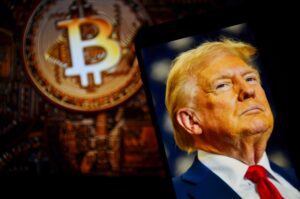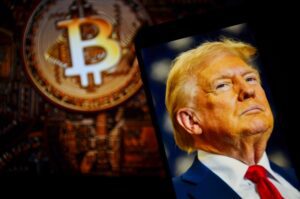Bitcoin hits new high as Trump’s ‘crypto week’ kicks off


Bitcoin surged to a record high on Monday, topping $123,000, as investors reacted to growing political and institutional support for cryptocurrency in the United States.
The surge comes at the start of what the Trump administration has dubbed “crypto week”, a concerted effort to establish digital assets as a core part of the American financial system.
The price of the world’s leading cryptocurrency has risen more than 30% since the start of the year, buoyed by record inflows into bitcoin exchange-traded funds and anticipation of regulatory clarity.
This week, the US House of Representatives is set to deliberate on the Genius Act, a landmark piece of legislation that would allow traditional banks to issue their own stablecoins—digital tokens pegged to fiat currencies like the US dollar. If passed, the law would mark a significant shift in how cryptocurrencies are integrated into the broader economy, potentially paving the way for mass adoption.
The bill has already triggered a wave of institutional interest. According to data from Farside Investors, bitcoin investment vehicles attracted $3.4 billion in inflows recently, including $2.2 billion in just the past two days—both figures setting new records.
President Trump has taken a markedly pro-crypto stance in recent months, positioning digital assets as a pillar of American innovation and financial leadership. His administration’s embrace of the industry has helped shift sentiment after years of regulatory uncertainty.
However, central banks remain cautious. In an interview with The Times, Bank of England governor Andrew Bailey expressed concerns over the proliferation of privately issued stablecoins.
“I would much rather commercial banks did not issue their own stablecoins,” Bailey said, warning that widespread adoption could pose systemic risks. The stablecoin market already exceeds $200 billion globally.
Despite such concerns, major institutions are pressing ahead. JP Morgan has confirmed plans to launch its own dollar-backed stablecoin, JPMD, while reports suggest other international banks are exploring joint ventures in the same space.
Amalia Neenan FitzGerald, an associate at law firm Peters & Peters, said the rise of stablecoin regulation could mark a turning point.
“Stablecoins have long posed regulatory challenges across jurisdictions,” she noted. “But now they are finally getting some much-needed time in the global regulatory spotlight. Whether such regulation proves workable remains to be seen, but it undoubtedly adds credibility to the crypto sector.”
Elsewhere, financial markets showed mixed reactions. Sterling slipped 0.2% to a three-week low of $1.34 against the dollar, following comments from Bailey suggesting the Bank of England may consider further interest rate cuts if the economy weakens. Rates have already fallen to 4.25% from a peak of 5.25% last August.
Gold hovered near record highs amid concerns over President Trump’s threats to impose a 30% tariff on imports from the EU and Mexico, which has unsettled global markets. Meanwhile, yields on French and German bonds approached levels not seen since the eurozone debt crisis, reflecting heightened investor anxiety.
As the debate around digital assets intensifies, the coming days could prove pivotal—not just for bitcoin’s trajectory, but for the future shape of global finance.
Read more:
Bitcoin hits new high as Trump’s ‘crypto week’ kicks off





